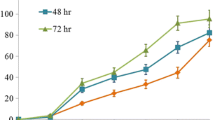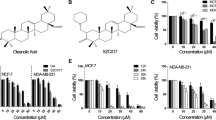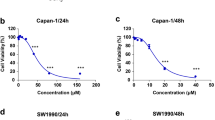Abstract
2α,3α,24-Thrihydroxyurs-12-en-28-oicacid (TEOA), a pentacyclic triterpenoid, isolated from the roots of Actinidia eriantha, exhibits significant cytotoxicity against SW620, BGC-823, HepG-2, A549 and PC-3 cancer cells. In this study, we investigated the underlying molecular mechanism of the anticancer activity of TEOA in SW620 cells. We demonstrated that TEOA induced apoptosis through cleavage of caspase-9 and PARP in SW620 cells. In addition, evidence of TEOA-mediated autophagy included the induction of autophagolysosomes and activation of autophagic markers LC-3B and p62. Further analysis illustrated that TEOA promoted the phosphorylation of PERK and elF2α, followed by up-regulation of the downstream protein CHOP, suggesting the involvement of PERK/eIF2α/CHOP pathway and ER stress in TEOA-induced autophagy in SW620 cells. Meanwhile, TEOA-mediated PINK1, Parkin, ubiquitin and p62 activation revealed that TEOA induced specific autophagy-mitophagy in SW620 cells. Additionally, an antioxidant NAC attenuated the TEOA-induced mitophagy, indicating that TEOA triggers mitophagy via a ROS-dependent pathway. Collectively, our findings revealed a novel cellular mechanism of TEOA in the colon cancer cell line SW620, thus providing a molecular basis for developing TEOA into an anti-tumor candidate.







Similar content being viewed by others
References
Bai X, Qiu A (2006) The liver-protective effect of the extracts from the Actinidia deliciosa Root. J Food Sci Biotechnol 6:024
Bertolotti A, Zhang Y, Hendershot LM, Harding HP, Ron D (2000) Dynamic interaction of BiP and ER stress transducers in the unfolded-protein response. Nat Cell Biol 2(6):326–332
Brewer JW, Diehl JA (2000) PERK mediates cell-cycle exit during the mammalian unfolded protein response. Proc Natl Acad Sci USA 97(23):12625–12630
Cullinan SB, Diehl JA (2004) PERK-dependent activation of Nrf2 contributes to redox homeostasis and cell survival following endoplasmic reticulum stress. J Biol Chem 279(19):20108–20117
Dagda RK, Cherra SJ, Kulich SM, Tandon A, Park D, Chu CT (2009) Loss of PINK1 function promotes mitophagy through effects on oxidative stress and mitochondrial fission. J Biol Chem 284(20):13843–13855
Ding WX, Ni HM, Gao W, Hou YF, Melan MA, Chen X, Stolz DB, Shao ZM, Yin XM (2007) Differential effects of endoplasmic reticulum stress-induced autophagy on cell survival. J Biol Chem 282(7):4702–4710
Ding WX, Ni HM, Li M, Liao Y, Chen X, Stolz DB, Dorn GW, Yin XM (2010) Nix is critical to two distinct phases of mitophagy, reactive oxygen species-mediated autophagy induction and Parkin-ubiquitin-p62-mediated mitochondrial priming. J Biol Chem 285(36):27879–27890
Durcan TM, Fon EA (2015) The three ‘P’s of mitophagy: PARKIN, PINK1, and post-translational modifications. Genes Dev 29(10):989–999
Fu WW, Tan CH, Lu LL, Meng XX, Luo HF, Zhu DY (2010) Chemical constituents from the root of Actinidia deliciosa. Chin J Nat Med 8(4):247–249
Garcia M, Meurs E, Esteban M (2007) The dsRNA protein kinase PKR: virus and cell control. Biochimie 89(6):799–811
Gegg ME, Schapira AH (2011) PINK1-parkin-dependent mitophagy involves ubiquitination of mitofusins 1 and 2: implications for Parkinson disease pathogenesis. Autophagy 7(2):243–245
Geisler S, Holmström KM, Skujat D, Fiesel FC, Rothfuss OC, Kahle PJ, Springer W (2010) PINK1/Parkin-mediated mitophagy is dependent on VDAC1 and p62/SQSTM1. Nat Cell Biol 12(2):119–131
Harding HP, Novoa I, Zhang Y, Zeng H, Wek R, Schapira M, Ron D (2000a) Regulated translation initiation controls stress-induced gene expression in mammalian cells. Mol Cell 6(5):1099–1108
Harding HP, Zhang Y, Bertolotti A, Zeng H, Ron D (2000b) Perk is essential for translational regulation and cell survival during the unfolded protein response. Mol Cell 5(5):897–904
Høyer-Hansen M, Jäättelä M (2007) Connecting endoplasmic reticulum stress to autophagy by unfolded protein response and calcium. Cell Death Differ 14(9):1576–1582
Jemal A, Bray F, Center MM, Ferlay J, Ward E, Forman D (2011) Global cancer statistics. CA Cancer J Clin 61(2):69–90
Joselin AP, Hewitt SJ, Callaghan SM, Kim RH, Chung Y-H, Mak TW, Shen J, Slack RS, Park DS (2012) ROS-dependent regulation of Parkin and DJ-1 localization during oxidative stress in neurons. Hum Mol Genet 21(22):4888–4903. doi:10.1093/hmg/dds325
Jousse C, Oyadomari S, Novoa I, Lu P, Zhang Y, Harding HP, Ron D (2003) Inhibition of a constitutive translation initiation factor 2α phosphatase, CReP, promotes survival of stressed cells. J Cell Biol 163(4):767–775
Kanki T, Klionsky DJ (2008) Mitophagy in yeast occurs through a selective mechanism. J Biol Chem 283(47):32386–32393
Kim I, Rodriguez-Enriquez S, Lemasters JJ (2007) Selective degradation of mitochondria by mitophagy. Arch Biochem Biophys 462(2):245–253
Kirkin V, McEwan DG, Novak I, Dikic I (2009) A role for ubiquitin in selective autophagy. Mol Cell 34(3):259–269
Kitada T, Asakawa S, Hattori N, Matsumine H, Yamamura Y, Minoshima S, Yokochi M, Mizuno Y, Shimizu N (1998) Mutations in the parkin gene cause autosomal recessive juvenile parkinsonism. Nature 392(6676):605–608
Koh H, Chung J (2012) PINK1 as a molecular checkpoint in the maintenance of mitochondrial function and integrity. Mol Cell 34(1):7–13
Kojima H, Ogura H (1989) Configurational studies on hydroxy groups at C-2, 3 and 23 or 24 of oleanene and ursene-type triterpenes by NMR spectroscopy. Phytochemistry 28(6):1703–1710
Kouroku Y, Fujita E, Tanida I, Ueno T, Isoai A, Kumagai H, Ogawa S, Kaufman R, Kominami E, Momoi T (2007) ER stress (PERK/eIF2α phosphorylation) mediates the polyglutamine-induced LC3 conversion, an essential step for autophagy formation. Cell Death Differ 14(2):230–239
Lai Y, Xu D (2007) Study on the chemical structure from the roots of Actinidia deliciosa. J Chin Med Mater 30(2):166–168
Lee AS (1987) Coordinated regulation of a set of genes by glucose and calcium ionophores in mammalian cells. Trends Biochem Sci 12:20–23
Lee AS (2001) The glucose-regulated proteins: stress induction and clinical applications. Trends Biochem Sci 26(8):504–510
Lee JY, Nagano Y, Taylor JP, Lim KL, Yao TP (2010) Disease-causing mutations in parkin impair mitochondrial ubiquitination, aggregation, and HDAC6-dependent mitophagy. J Cell Biol 189(4):671–679
Liang J, Wang X, Zhen H, Zhong Z, Zhang W, Zhang W, Li W (2007) Study on anti-tumor effect of extractions from roots of Actinidia deliciosa. J Chin Med Mater 30(10):1279–1282
Lin S, Yu P, Zhu S, Wu X, Yu B (1987) Preliminary study on anticancer effect and affecting mouse immune function of crude extracts from the Actinintia eriantha Benth root. J Fujian Norm Univ (Nat Sci Ed) 3(2):108–110
Lu PD, Jousse C, Marciniak SJ, Zhang Y, Novoa I, Scheuner D, Kaufman RJ, Ron D, Harding HP (2004) Cytoprotection by pre-emptive conditional phosphorylation of translation initiation factor 2. EMBO J 23(1):169–179
Lugea A, Tischler D, Nguyen J, Gong J, Gukovsky I, French SW, Gorelick FS, Pandol SJ (2011) Adaptive unfolded protein response attenuates alcohol-induced pancreatic damage. Gastroenterology 140(3):987–997
Matsuda N, Sato S, Shiba K, Okatsu K, Saisho K, Gautier CA, Y-s Sou, Saiki S, Kawajiri S, Sato F (2010) PINK1 stabilized by mitochondrial depolarization recruits Parkin to damaged mitochondria and activates latent Parkin for mitophagy. J Cell Biol 189(2):211–221
Mizushima N, Levine B, Cuervo AM, Klionsky DJ (2008) Autophagy fights disease through cellular self-digestion. Nature 451(7182):1069–1075
Narendra DP, Jin SM, Tanaka A, Suen DF, Gautier CA, Shen J, Cookson MR, Youle RJ (2010) PINK1 is selectively stabilized on impaired mitochondria to activate Parkin. PLoS Biol 8(1):e1000298
Obrand DI, Gordon PH (1997) Incidence and patterns of recurrence following curative resection for colorectal carcinoma. Dis Colon Rectum 40(1):15–24
Okatsu K, Saisho K, Shimanuki M, Nakada K, Shitara H, Ys Sou, Kimura M, Sato S, Hattori N, Komatsu M (2010) p62/SQSTM1 cooperates with Parkin for perinuclear clustering of depolarized mitochondria. Genes Cells 15(8):887–900
Sakakibara J, Kaiya T (1983) Terpenoids of Rhododendron japonicum. Phytochemistry 22(11):2547–2552
Sandoval H, Thiagarajan P, Dasgupta SK, Schumacher A, Prchal JT, Chen M, Wang J (2008) Essential role for Nix in autophagic maturation of erythroid cells. Nature 454(7201):232–235
Sano R, Reed JC (2013) ER stress-induced cell death mechanisms. BBA Mol Cell Res 1833(12):3460–3470
Satoh H (2014) Pharmacological effectiveness of the active phytochemicals contained in foods and herbs. J Intercult Ethnopharmacol 3(4):196
Scheuner D, Song B, McEwen E, Liu C, Laybutt R, Gillespie P, Saunders T, Bonner-Weir S, Kaufman RJ (2001) Translational control is required for the unfolded protein response and in vivo glucose homeostasis. Mol Cell 7(6):1165–1176
Schweers RL, Zhang J, Randall MS, Loyd MR, Li W, Dorsey FC, Kundu M, Opferman JT, Cleveland JL, Miller JL (2007) NIX is required for programmed mitochondrial clearance during reticulocyte maturation. Proc Natl Acad Sci USA 104(49):19500–19505
Tabas I, Ron D (2011) Integrating the mechanisms of apoptosis induced by endoplasmic reticulum stress. Nat Cell Biol 13(3):184–190
Tallóczy Z, Jiang W, Virgin HW, Leib DA, Scheuner D, Kaufman RJ, Eskelinen E-L, Levine B (2002) Regulation of starvation-and virus-induced autophagy by the eIF2α kinase signaling pathway. Proc Natl Acad Sci USA 99(1):190–195
Tolkovsky AM (2009) Mitophagy. BBA Mol Cell Res 1793(9):1508–1515
Verfaillie T, Rubio N, Garg A, Bultynck G, Rizzuto R, Decuypere J, Piette J, Linehan C, Gupta S, Samali A (2012) PERK is required at the ER-mitochondrial contact sites to convey apoptosis after ROS-based ER stress. Cell Death Differ 19(11):1880–1891
Wang Y, Nartiss Y, Steipe B, McQuibban GA, Kim PK (2012) ROS-induced mitochondrial depolarization initiates PARK2/PARKIN-dependent mitochondrial degradation by autophagy. Autophagy 8(10):1462–1476
Youle RJ, Narendra DP (2011) Mechanisms of mitophagy. Nat Rev Mol Cell Biol 12(1):9–14
Zhang J, Ney PA (2009) Role of BNIP3 and NIX in cell death, autophagy, and mitophagy. Cell Death Differ 16(7):939–946
Zhang X, Chen LX, Ouyang L, Cheng Y, Liu B (2012) Plant natural compounds: targeting pathways of autophagy as anti-cancer therapeutic agents. Cell Prolif 45(5):466–476
Zhong Z, Zhang F, Zhen H, Zhang W, Wu H, Wei H (2003) Experimental study on the antitumor effects of extracts from roots of Acitinidia delicilsa in carcinoma cell lines. Chin Arch Tradit Chin Med 22(9):1705–1707
Zhou X, Liu Y, Tang L, Zhang P, Wu J (2010) Chemical constituents from the roots of Actinidia chinensis. Chem Nat Compd 46(2):308–309
Acknowledgements
This work was supported by the National Science Foundation of China (Grant No. 81473182), the Jiangsu Provincial Natural Science Foundation of China (Grant No. BK20161269) and the Jiangsu Technology Support Program (Grant No. BE2014654).
Author information
Authors and Affiliations
Corresponding author
Ethics declarations
Conflict of interest
We declare that we have no financial and personal relationships with other people or organizations that can inappropriately influence our work, there is no professional or other personal interest of any nature or kind in any product, service and/or company that could be construed as influencing the position presented in, or the review of, the manuscript entitled.
Electronic supplementary material
Below is the link to the electronic supplementary material.
Rights and permissions
About this article
Cite this article
Zhang, D., Gao, C., Li, R. et al. TEOA, a triterpenoid from Actinidia eriantha, induces autophagy in SW620 cells via endoplasmic reticulum stress and ROS-dependent mitophagy. Arch. Pharm. Res. 40, 579–591 (2017). https://doi.org/10.1007/s12272-017-0899-9
Received:
Accepted:
Published:
Issue Date:
DOI: https://doi.org/10.1007/s12272-017-0899-9




